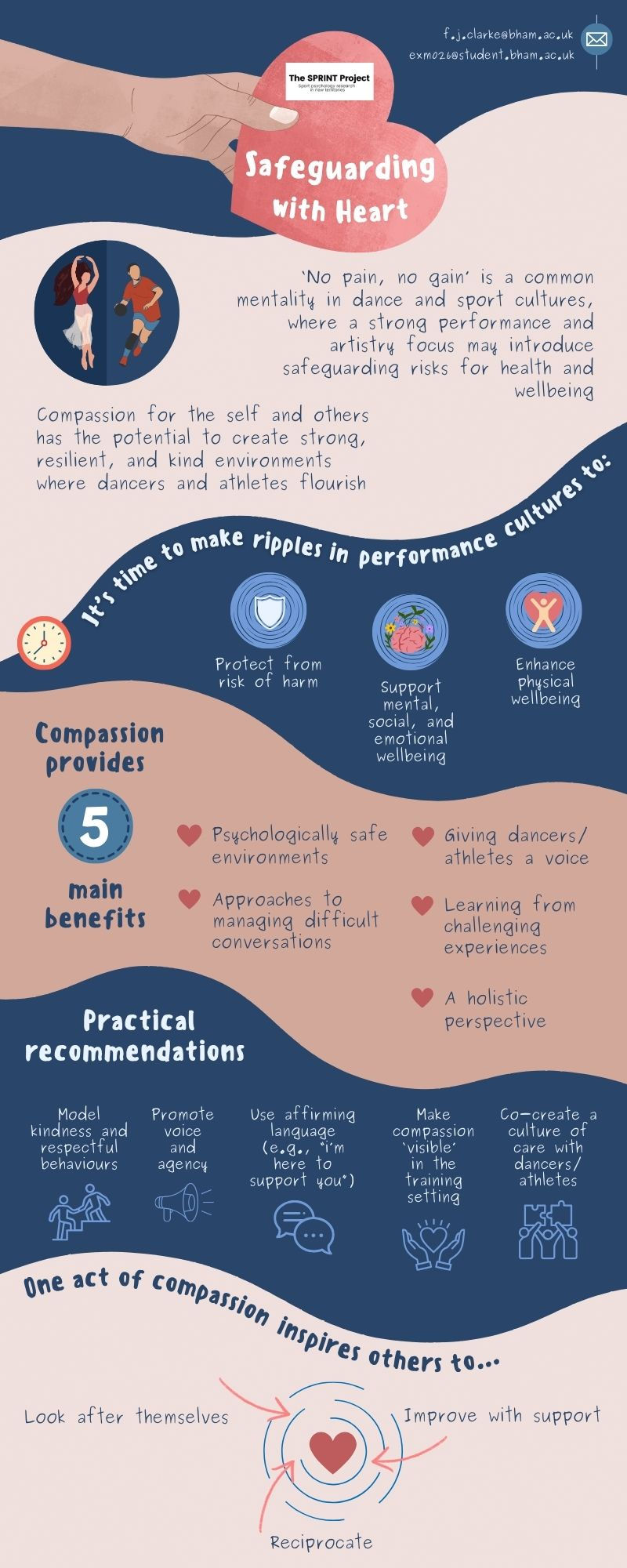Safeguarding with Heart: Creating Compassionate Cultures in Dance and Sport
- SPRINT project

- Sep 12
- 4 min read
Dance and sport are contexts where individuals and groups perform, often to a high standard and under both internal and external pressure. For example, individuals might
· demonstrate highly perfectionistic tendencies
· be self-critical in their pursuit of artistry and excellence
· experience pressure from teachers and coaches to ‘win at all costs’.

For a long time, these pressures and unspoken expectations have become part of the cultural norm in dance and sport, where the environment encourages a high-performance focus, at the risk of harm to both mental and physical wellbeing.
Safeguarding
To better understand the risk and protective factors for wellbeing and safety in these contexts, an applied body of research led by Prof Jennifer Cumming seeks to understand more about safeguarding and abuse prevention. Results from the first national survey in dance provided an overview of current policies in place and explored the experiences of those in the sector. For more information, you can read about the results of the survey, and check out an infographic from a scoping review led by PhD student Michelle Dwarika.
Compassion
Adding to this body of research, PhD projects led by SPRINT project students Emma Morgan and Fiona J. Clarke have been researching the potential of compassion to support dancer and athlete wellbeing and performance.
Compassion is a sensitivity to suffering in the self or others, and a motivation to alleviate and prevent it.
Gilbert et al., 2017.
A new direction for compassion research
Self-compassion has been increasingly studied in the context of sport, yet not so readily in dance settings. PhD student Emma Morgan is bridging this gap by exploring dance students’ experiences with self-compassion. At the same time, research is only now beginning to identify the need to explore compassion for others in sport and dance contexts, too. PhD student Fiona J. Clarke is therefore currently leading on developing a conceptualisation of compassion for others in team sport.

But how does compassion fit into the safeguarding and abuse prevention agenda? And how might the different strands of research (i.e., self- and others-compassion, dance, and sport) be united to offer a targeted approach to wellbeing promotion?

Weaving compassion and safeguarding together
Compassion has the potential to play a vital role in safeguarding to help identify and address risk factors before they escalate into harm. It fosters trust, encourages help-seeking, and nurtures environments where individuals feel safe to speak up.
Importantly, compassion expands our understanding of what it means to support others in high-pressure performance settings. It shifts safeguarding beyond policies and procedures toward a more relational, responsive culture - one grounded in humanity and shared responsibility.
As shown in the ‘Safeguarding with Heart’ infographic, compassion acts as the source of protective ripples. It fosters psychological safety and supports holistic wellbeing. Rather than being an ‘add-on’, compassion becomes the foundation from which these ripples emerge, radiating outward to strengthen safeguarding practices across training environments.
Practical recommendations
Below are five ways to embed compassion into training environments to support safeguarding across dance and sport:
· Lead by example: coaches, teachers, and peers can model kindness and respectful behaviours and show what compassion looks like in action.
· Promote voice and agency: invite dancers and athletes to contribute their views, especially around decisions that affect them. Prioritise open communication and establish regular feedback loops to ensure all voices are heard, valued, and acted upon. See this recent blog post for more ideas.
· Use affirming language: the words we choose can either create safety or distance.
Simple phrases like “I’m here to support you”, or “It’s okay to feel this way”, can help validate emotional experiences, reduce fear, and build trust.
· Make compassion visible in the training setting: integrate compassion into training routines with intentional compassion practices, such as group check-ins, gratitude circles, or reflective pauses.
· Co-create a culture of care: encourage shared responsibility for wellbeing among all members of training spaces.
Call to action
Compassion connects. It helps create cultures where people look out for one another, not just in moments of crisis, but every day. When compassion is visible and shared, it sends a powerful signal: you matter here.
Just one act of compassion can start a ripple effect, making it more likely that others will:
Look after themselves
Support one another
Speak up when something feels wrong
Let’s safeguard with heart - together.
Written by Fiona Clarke and Emma Morgan (PhD students in the SPRINT Project)
Image credit: Canva
Reference:
Gilbert, P., Catarino, F., Duarte, C., Matos, M., Kolts, R., Stubbs, J., Ceresatto, L., Duarte, J., Pinto-Gouveia, J., and Basran, J. (2017). The development of compassionate engagement and action scales for self and others. Journal of Compassionate Health Care, 4(4), 1-24. https://doi.org/10.1186/s40639-017-0033-3
To cite the infographic:
Clarke, F.J. and Morgan, E., 2025, Safeguarding with heart (Infographic), The SPRINT Project, https://sprintproject.org
To cite this blog post: Clarke, F.J. and Morgan, E., [date], Safeguarding with heart: Creating compassionate cultures in dance and sport, The SPRINT Project, https://sprintproject.org/blog



Comments